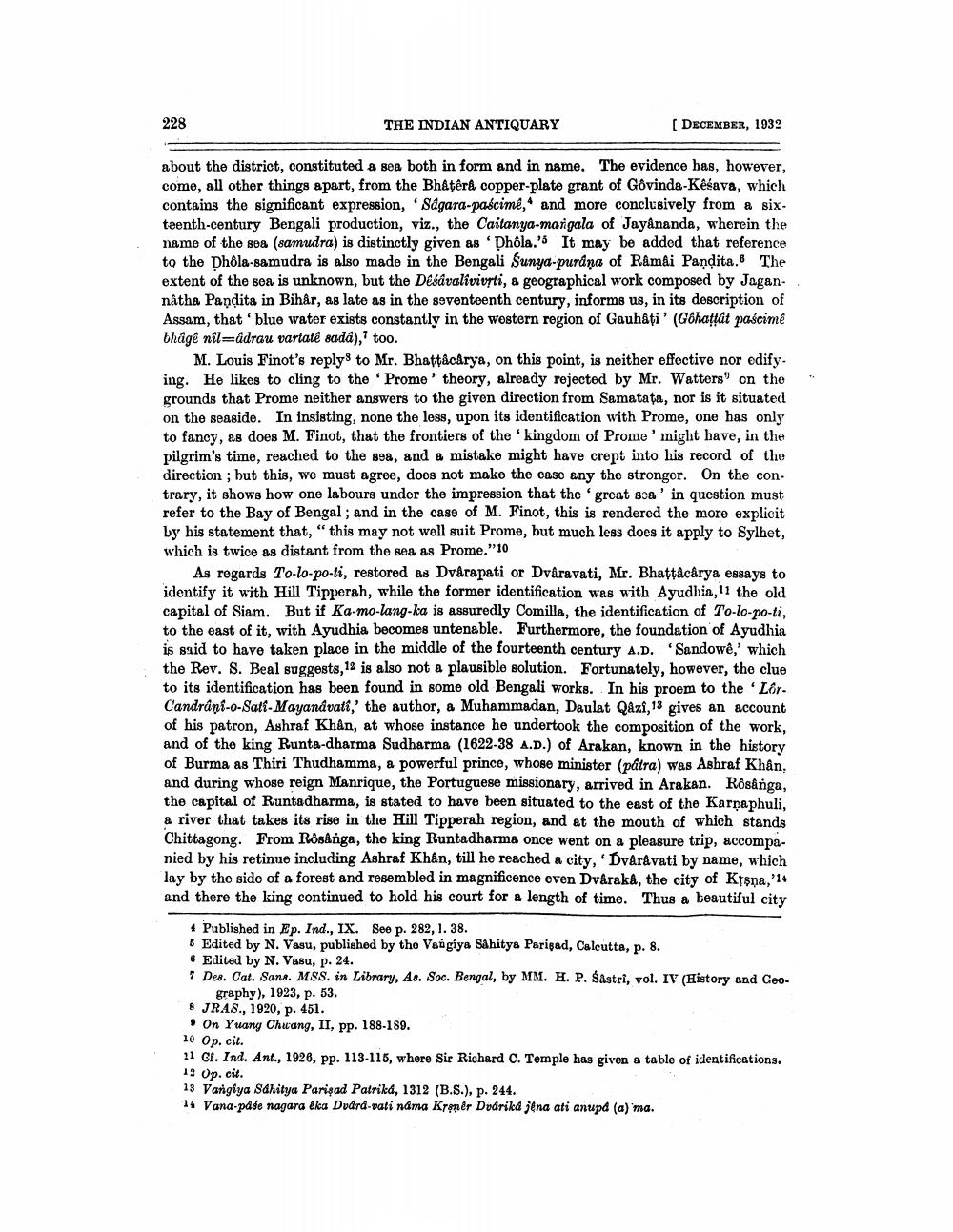________________
228
THE INDIAN ANTIQUARY
[DECEMBER, 1932
about the district, constituted a sea both in form and in name. The evidence has, however, come, all other things apart, from the Bhâtêrâ copper-plate grant of Govinda-Kesava, which contains the significant expression, Sagara-paścime, and more conclusively from a sixteenth-century Bengali production, viz., the Caitanya-marigala of Jayananda, wherein the name of the sea (samudra) is distinctly given as 'Dhôla.'5 It may be added that reference to the phôla-samudra is also made in the Bengali Sunya-purana of Râmâi Pandita. The extent of the sea is unknown, but the Désávalîvivṛti, a geographical work composed by Jagannâtha Pandita in Bihar, as late as in the seventeenth century, informs us, in its description of Assam, that 'blue water exists constantly in the western region of Gauhati' (Gôhaṭṭât paścimê bhagê nîl âdrau vartatê sada), too.
M. Louis Finot's replys to Mr. Bhattâcârya, on this point, is neither effective nor edifying. He likes to cling to the Prome' theory, already rejected by Mr. Watters" on the grounds that Prome neither answers to the given direction from Samatata, nor is it situated on the seaside. In insisting, none the less, upon its identification with Prome, one has only to fancy, as does M. Finot, that the frontiers of the kingdom of Prome' might have, in the pilgrim's time, reached to the sea, and a mistake might have crept into his record of the direction; but this, we must agree, does not make the case any the stronger. On the contrary, it shows how one labours under the impression that the great sea' in question must refer to the Bay of Bengal; and in the case of M. Finot, this is rendered the more explicit by his statement that, "this may not well suit Prome, but much less does it apply to Sylhet, which is twice as distant from the sea as Prome."10
As regards To-lo-po-ti, restored as Dvârapati or Dvaravati, Mr. Bhattâcârya essays to identify it with Hill Tipperah, while the former identification was with Ayudhia, 11 the old capital of Siam. But if Ka-mo-lang-ka is assuredly Comilla, the identification of To-lo-po-ti, to the east of it, with Ayudhia becomes untenable. Furthermore, the foundation of Ayudhia is said to have taken place in the middle of the fourteenth century A.D. 'Sandowê,' which the Rev. S. Beal suggests, 12 is also not a plausible solution. Fortunately, however, the clue to its identification has been found in some old Bengali works. In his proem to the 'LorCandrani-o-Sati-Mayanâvati,' the author, a Muhammadan, Daulat Qazî,13 gives an account of his patron, Ashraf Khân, at whose instance he undertook the composition of the work, and of the king Runta-dharma Sudharma (1622-38 A.D.) of Arakan, known in the history of Burma as Thiri Thudhamma, a powerful prince, whose minister (pâtra) was Ashraf Khân. and during whose reign Manrique, the Portuguese missionary, arrived in Arakan. Rosânga, the capital of Runtadharma, is stated to have been situated to the east of the Karnaphuli, a river that takes its rise in the Hill Tipperah region, and at the mouth of which stands Chittagong. From Rôsânga, the king Runtadharma once went on a pleasure trip, accompanied by his retinue including Ashraf Khân, till he reached a city, 'Dvârâvati by name, which lay by the side of a forest and resembled in magnificence even Dvârakâ, the city of Krsna,'14 and there the king continued to hold his court for a length of time. Thus a beautiful city
4 Published in Ep. Ind., IX. See p. 282, 1. 38.
Edited by N. Vasu, published by the Vaugiya Sahitya Parisad, Calcutta, p. 8.
6 Edited by N. Vasu, p. 24.
7 Des. Cat. Sans. MSS. in Library, As. Soc. Bengal, by MM. H. P. Sastri, vol. IV (History and Geography), 1923, p. 53.
8 JRAS., 1920, p. 451.
9 On Yuany Chuang, II, pp. 188-189.
10 Op. cit.
11 Cf. Ind. Ant., 1926, pp. 113-115, where Sir Richard C. Temple has given a table of identifications. 12 Op. cit.
13 Vangiya Sahitya Parisad Patriká, 1312 (B.S.), p. 244.
14 Vana-páse nagara éka Dvdrá-vati nama Kremêr Dváriká jena ati anupd (a) ma.




